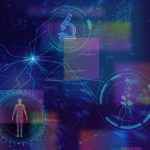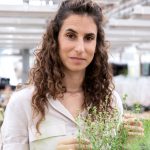Insights Weiwei Fan Life is energy
The ancient Chinese concept of qi (pronounced chee) describes the vital life force, how energy flows throughout the body and the universe.
Weiwei Fan, a staff scientist in Professor Ronald Evans’ lab, sees qi as a way of explaining the complex interactions in our universe that lead to energy generation in our cells. For example, the sun shines on planet Earth, providing light energy to plants. Plants have structures called chloroplasts that use the energy from the sun’s rays to make carbohydrates (simple sugars) from carbon dioxide in a process called photosynthesis. Animals then eat plants and their mitochondria (the cell’s powerhouses), converting the chemical energy from food into usable energy for the animal. This flow of energy is the basis of life.
“It’s not a coincidence that I study mitochondria,” says Fan. “I feel drawn to understanding how these energy generators within our cells function and the natural variations that exist between individuals.”
Early Life
Fan grew up in the small Chinese city of Tongxiang, roughly two hours east of Shanghai. His father was a farmer-turned-businessman and his mother taught math at the local elementary school. Although he loved math, Fan became captivated by biology in high school when his teacher inspired him to think about biological problems and how to solve them, instead of just memorizing facts.
Around this time, Dolly the sheep had just been cloned—she was the first mammal to be cloned from an adult cell—and this advancement made a big impact on Fan’s trajectory. “I remember reading a report about Dolly the sheep that said, ‘The next century will be the century of biology.’ I knew then that I had to be part of that revolution,” says Fan.
Path to Salk
Fan attended Fudan University in Shanghai where he majored in biology and life sciences. There, he also met his wife, who is a scientist too. Together, they applied to doctoral programs around the world and were both accepted to UC Irvine.
Fan joined the lab of Douglas Wallace, who is one of the founders of the field of human mitochondrial genetics. Wallace also founded the Center for Molecular and Mitochondrial Medicine and Genetics at UC Irvine. There, Fan dove into exploring the differences in mitochondrial DNA to understand how variations impact the onset of disease.
“Everyone’s mitochondria are slightly different. Some people have mitochondria that produce a lot of energy, while others’ mitochondria generate heat,” says Fan. “These differences in function play an important role in evolution and adaptation and are linked to the onset of diseases, such as Alzheimer’s disease.”
Fan was one of the first people to develop animal models with mitochondrial DNA mutations to better understand these differences.
Research at Salk
After completing his PhD, Fan joined Evans’ lab to examine how exercise impacts mitochondrial energy metabolism in muscle tissue. The team’s goal was to develop an “exercise mimetic,” a pill that could be taken to mimic the effects of exercise for those who are unable to exercise, such as those who have Alzheimer’s disease or movement limitations.
In 2017, Fan and the Evans team published a seminal paper in Cell Metabolism about the pill they developed that boosted the athletic endurance of sedentary mice by 70 percent.
“We essentially showed that it’s possible to improve endurance to the equivalent level as someone in training, without all of the physical effort,” says Fan.
The compound has since been licensed to a biotechnology company that plans to develop a version safe for human use and test whether it can treat certain diseases.
“There is great potential for the field of mitochondrial biology. With recent advancements in genetic engineering, we can now edit mitochondrial DNA to answer new questions about evolution, adaptation, and the stress response.”
–Weiwei Fan
Day-to-Day
Fan has now been at Salk for 13 years. As a staff scientist, he directs research projects under the guidance of Evans and applies for independent grants. Fan’s goal is to secure enough funding so he can start his own lab to focus on mitochondrial regulation and variation. For example, Fan wants to develop new mouse models that can better mimic human mitochondrial diseases, such as Leber hereditary optic neuropathy, which causes vision loss.
He is also interested in examining mitochondrial variations in people who live in different regions around the world. Research suggests that people who live in colder climates have mitochondria that generate less energy and more heat, whereas people in tropical regions have mitochondria that create more energy and less heat.
People who generate more heat may naturally burn more calories and have a lower risk of obesity. Additionally, generating large amounts of energy leads to the creation of reactive oxygen species, which damage cells, speed up aging, and are associated with Alzheimer’s disease.
Some mitochondrial variations may also lead to resistance against certain diseases or increase susceptibility to other diseases. Fan plans to make mouse models to test whether this theory is correct.
Leisure Time
Fan and his wife have two daughters, ages 13 and 17. The family enjoys biking along the State Route 56 bike path, hiking the Los Peñasquitos Canyon Trail to the waterfall, and trying different hot pot restaurants around San Diego. Although Fan is an excellent cook, he still enjoys visiting authentic Chinese restaurants like Spice City and Haidilao.
Fun Facts
Fan jokes that he looks much older than his wife because he has gray hair. “My wife often gets mistaken for one of my daughters—which she loves—when we go out,” he laughs.
Long View / Future Projects
“There is great potential for the field of mitochondrial biology. With recent advancements in genetic engineering, we can now edit mitochondrial DNA to answer new questions about evolution, adaptation, and the stress response,” says Fan. “I’m excited to apply this technology to my own research to examine mitochondrial diseases.”
Support a legacy where cures begin.
Featured Stories
 Leading with Technology – Salk scientists develop new means of discoveryOur scientists continue to push technological limits to—among other things—store more excess atmospheric carbon in deeper plant roots, study pancreatic cancer more accurately, follow cellular activity in real time more clearly, and track all kinds of motion more easily.
Leading with Technology – Salk scientists develop new means of discoveryOur scientists continue to push technological limits to—among other things—store more excess atmospheric carbon in deeper plant roots, study pancreatic cancer more accurately, follow cellular activity in real time more clearly, and track all kinds of motion more easily. Dannielle Engle—Putting patients firstEngle, an assistant professor, has a deeply personal connection to pancreatic cancer that changed her career trajectory and made her want to focus on the disease. Inside Salk sat down with Engle to find out more about her dedication to finding better treatment options.
Dannielle Engle—Putting patients firstEngle, an assistant professor, has a deeply personal connection to pancreatic cancer that changed her career trajectory and made her want to focus on the disease. Inside Salk sat down with Engle to find out more about her dedication to finding better treatment options.
 Weiwei Fan—Life is energyFan, a staff scientist in Professor Ronald Evans’ lab, studies mitochondria because he feels drawn to understanding how these energy generators within our cells function and the natural variations that exist between individuals.
Weiwei Fan—Life is energyFan, a staff scientist in Professor Ronald Evans’ lab, studies mitochondria because he feels drawn to understanding how these energy generators within our cells function and the natural variations that exist between individuals. Natanella Illouz-Eliaz—Recipe for a plant biologist: tomatoes, failure, and perseveranceIllouz-Eliaz, a postdoctoral researcher in Professor Joseph Ecker’s lab, grew up in Israel near the border with Lebanon, where high-pitched sirens periodically drove her family into bomb shelters for safety. But her parents insisted that she get the best education possible.
Natanella Illouz-Eliaz—Recipe for a plant biologist: tomatoes, failure, and perseveranceIllouz-Eliaz, a postdoctoral researcher in Professor Joseph Ecker’s lab, grew up in Israel near the border with Lebanon, where high-pitched sirens periodically drove her family into bomb shelters for safety. But her parents insisted that she get the best education possible. Richard Heyman—From Salk to biotech and backHeyman, a scientist and entrepreneur who has founded numerous biotechnology companies, currently serves as vice chair of Salk’s Board of Trustees, but his Salk story actually began when he was a postdoctoral researcher in the lab of Professor Ronald Evans.
Richard Heyman—From Salk to biotech and backHeyman, a scientist and entrepreneur who has founded numerous biotechnology companies, currently serves as vice chair of Salk’s Board of Trustees, but his Salk story actually began when he was a postdoctoral researcher in the lab of Professor Ronald Evans.




















































